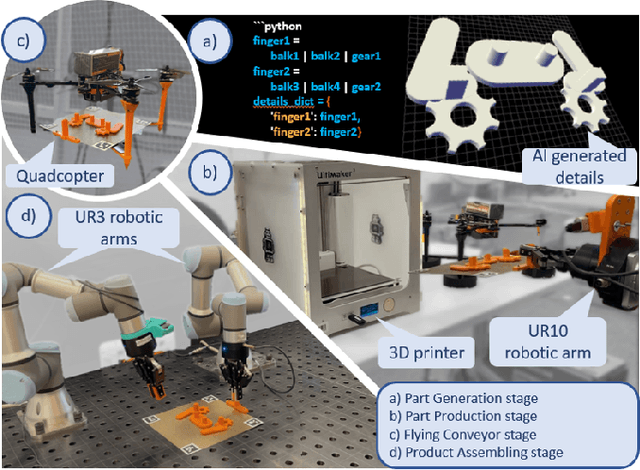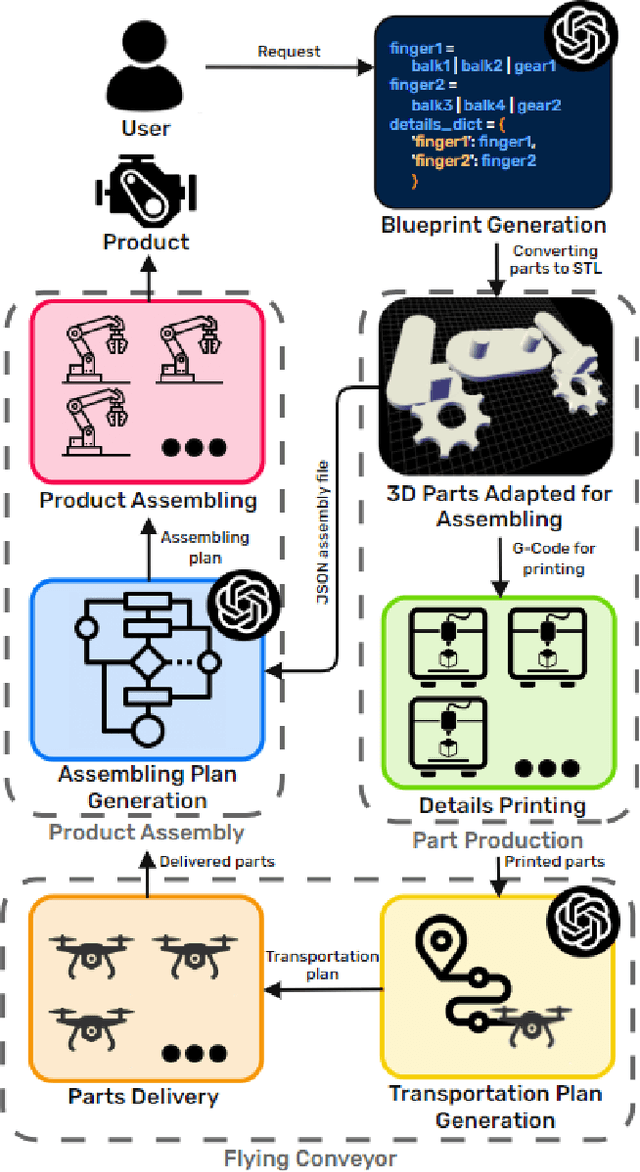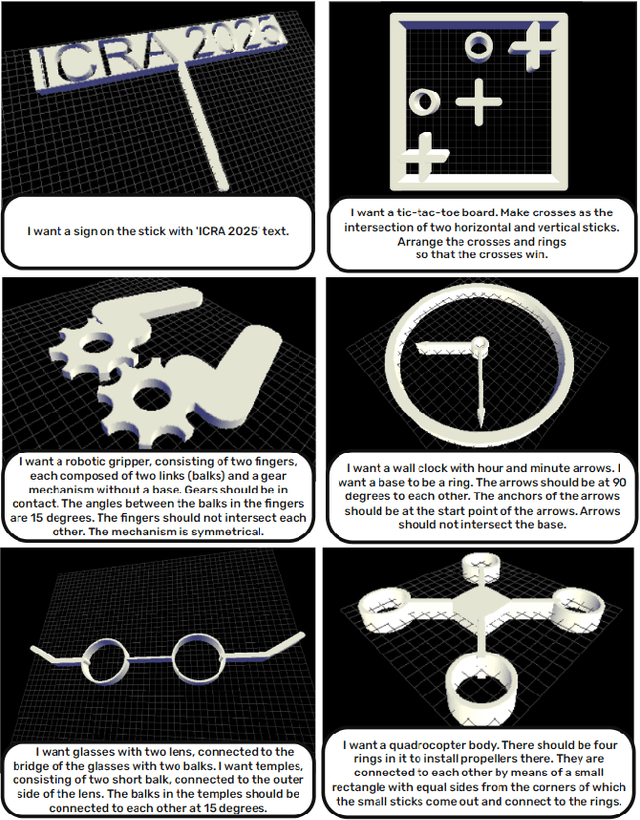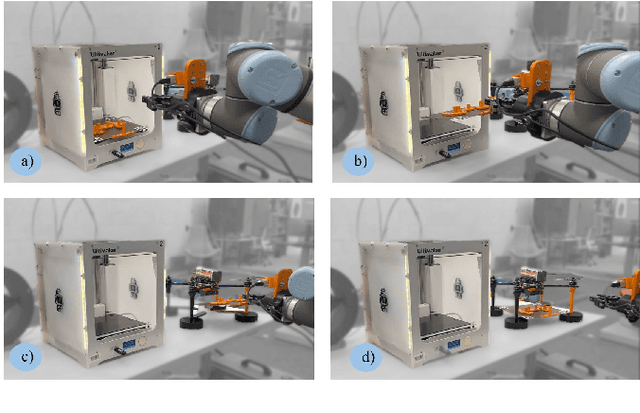Artem Lykov
UAV-VLPA*: A Vision-Language-Path-Action System for Optimal Route Generation on a Large Scales
Mar 04, 2025Abstract:The UAV-VLPA* (Visual-Language-Planning-and-Action) system represents a cutting-edge advancement in aerial robotics, designed to enhance communication and operational efficiency for unmanned aerial vehicles (UAVs). By integrating advanced planning capabilities, the system addresses the Traveling Salesman Problem (TSP) to optimize flight paths, reducing the total trajectory length by 18.5\% compared to traditional methods. Additionally, the incorporation of the A* algorithm enables robust obstacle avoidance, ensuring safe and efficient navigation in complex environments. The system leverages satellite imagery processing combined with the Visual Language Model (VLM) and GPT's natural language processing capabilities, allowing users to generate detailed flight plans through simple text commands. This seamless fusion of visual and linguistic analysis empowers precise decision-making and mission planning, making UAV-VLPA* a transformative tool for modern aerial operations. With its unmatched operational efficiency, navigational safety, and user-friendly functionality, UAV-VLPA* sets a new standard in autonomous aerial robotics, paving the way for future innovations in the field.
RaceVLA: VLA-based Racing Drone Navigation with Human-like Behaviour
Mar 04, 2025Abstract:RaceVLA presents an innovative approach for autonomous racing drone navigation by leveraging Visual-Language-Action (VLA) to emulate human-like behavior. This research explores the integration of advanced algorithms that enable drones to adapt their navigation strategies based on real-time environmental feedback, mimicking the decision-making processes of human pilots. The model, fine-tuned on a collected racing drone dataset, demonstrates strong generalization despite the complexity of drone racing environments. RaceVLA outperforms OpenVLA in motion (75.0 vs 60.0) and semantic generalization (45.5 vs 36.3), benefiting from the dynamic camera and simplified motion tasks. However, visual (79.6 vs 87.0) and physical (50.0 vs 76.7) generalization were slightly reduced due to the challenges of maneuvering in dynamic environments with varying object sizes. RaceVLA also outperforms RT-2 across all axes - visual (79.6 vs 52.0), motion (75.0 vs 55.0), physical (50.0 vs 26.7), and semantic (45.5 vs 38.8), demonstrating its robustness for real-time adjustments in complex environments. Experiments revealed an average velocity of 1.04 m/s, with a maximum speed of 2.02 m/s, and consistent maneuverability, demonstrating RaceVLA's ability to handle high-speed scenarios effectively. These findings highlight the potential of RaceVLA for high-performance navigation in competitive racing contexts. The RaceVLA codebase, pretrained weights, and dataset are available at this http URL: https://racevla.github.io/
CognitiveDrone: A VLA Model and Evaluation Benchmark for Real-Time Cognitive Task Solving and Reasoning in UAVs
Mar 03, 2025Abstract:This paper introduces CognitiveDrone, a novel Vision-Language-Action (VLA) model tailored for complex Unmanned Aerial Vehicles (UAVs) tasks that demand advanced cognitive abilities. Trained on a dataset comprising over 8,000 simulated flight trajectories across three key categories-Human Recognition, Symbol Understanding, and Reasoning-the model generates real-time 4D action commands based on first-person visual inputs and textual instructions. To further enhance performance in intricate scenarios, we propose CognitiveDrone-R1, which integrates an additional Vision-Language Model (VLM) reasoning module to simplify task directives prior to high-frequency control. Experimental evaluations using our open-source benchmark, CognitiveDroneBench, reveal that while a racing-oriented model (RaceVLA) achieves an overall success rate of 31.3%, the base CognitiveDrone model reaches 59.6%, and CognitiveDrone-R1 attains a success rate of 77.2%. These results demonstrate improvements of up to 30% in critical cognitive tasks, underscoring the effectiveness of incorporating advanced reasoning capabilities into UAV control systems. Our contributions include the development of a state-of-the-art VLA model for UAV control and the introduction of the first dedicated benchmark for assessing cognitive tasks in drone operations. The complete repository is available at cognitivedrone.github.io
Evolution 6.0: Evolving Robotic Capabilities Through Generative Design
Feb 25, 2025Abstract:We propose a new concept, Evolution 6.0, which represents the evolution of robotics driven by Generative AI. When a robot lacks the necessary tools to accomplish a task requested by a human, it autonomously designs the required instruments and learns how to use them to achieve the goal. Evolution 6.0 is an autonomous robotic system powered by Vision-Language Models (VLMs), Vision-Language Action (VLA) models, and Text-to-3D generative models for tool design and task execution. The system comprises two key modules: the Tool Generation Module, which fabricates task-specific tools from visual and textual data, and the Action Generation Module, which converts natural language instructions into robotic actions. It integrates QwenVLM for environmental understanding, OpenVLA for task execution, and Llama-Mesh for 3D tool generation. Evaluation results demonstrate a 90% success rate for tool generation with a 10-second inference time, and action generation achieving 83.5% in physical and visual generalization, 70% in motion generalization, and 37% in semantic generalization. Future improvements will focus on bimanual manipulation, expanded task capabilities, and enhanced environmental interpretation to improve real-world adaptability.
GestLLM: Advanced Hand Gesture Interpretation via Large Language Models for Human-Robot Interaction
Jan 14, 2025Abstract:This paper introduces GestLLM, an advanced system for human-robot interaction that enables intuitive robot control through hand gestures. Unlike conventional systems, which rely on a limited set of predefined gestures, GestLLM leverages large language models and feature extraction via MediaPipe to interpret a diverse range of gestures. This integration addresses key limitations in existing systems, such as restricted gesture flexibility and the inability to recognize complex or unconventional gestures commonly used in human communication. By combining state-of-the-art feature extraction and language model capabilities, GestLLM achieves performance comparable to leading vision-language models while supporting gestures underrepresented in traditional datasets. For example, this includes gestures from popular culture, such as the ``Vulcan salute" from Star Trek, without any additional pretraining, prompt engineering, etc. This flexibility enhances the naturalness and inclusivity of robot control, making interactions more intuitive and user-friendly. GestLLM provides a significant step forward in gesture-based interaction, enabling robots to understand and respond to a wide variety of hand gestures effectively. This paper outlines its design, implementation, and evaluation, demonstrating its potential applications in advanced human-robot collaboration, assistive robotics, and interactive entertainment.
UAV-VLA: Vision-Language-Action System for Large Scale Aerial Mission Generation
Jan 09, 2025Abstract:The UAV-VLA (Visual-Language-Action) system is a tool designed to facilitate communication with aerial robots. By integrating satellite imagery processing with the Visual Language Model (VLM) and the powerful capabilities of GPT, UAV-VLA enables users to generate general flight paths-and-action plans through simple text requests. This system leverages the rich contextual information provided by satellite images, allowing for enhanced decision-making and mission planning. The combination of visual analysis by VLM and natural language processing by GPT can provide the user with the path-and-action set, making aerial operations more efficient and accessible. The newly developed method showed the difference in the length of the created trajectory in 22% and the mean error in finding the objects of interest on a map in 34.22 m by Euclidean distance in the K-Nearest Neighbors (KNN) approach.
Industry 6.0: New Generation of Industry driven by Generative AI and Swarm of Heterogeneous Robots
Sep 16, 2024



Abstract:This paper presents the concept of Industry 6.0, introducing the world's first fully automated production system that autonomously handles the entire product design and manufacturing process based on user-provided natural language descriptions. By leveraging generative AI, the system automates critical aspects of production, including product blueprint design, component manufacturing, logistics, and assembly. A heterogeneous swarm of robots, each equipped with individual AI through integration with Large Language Models (LLMs), orchestrates the production process. The robotic system includes manipulator arms, delivery drones, and 3D printers capable of generating assembly blueprints. The system was evaluated using commercial and open-source LLMs, functioning through APIs and local deployment. A user study demonstrated that the system reduces the average production time to 119.10 minutes, significantly outperforming a team of expert human developers, who averaged 528.64 minutes (an improvement factor of 4.4). Furthermore, in the product blueprinting stage, the system surpassed human CAD operators by an unprecedented factor of 47, completing the task in 0.5 minutes compared to 23.5 minutes. This breakthrough represents a major leap towards fully autonomous manufacturing.
VR-GPT: Visual Language Model for Intelligent Virtual Reality Applications
May 19, 2024Abstract:The advent of immersive Virtual Reality applications has transformed various domains, yet their integration with advanced artificial intelligence technologies like Visual Language Models remains underexplored. This study introduces a pioneering approach utilizing VLMs within VR environments to enhance user interaction and task efficiency. Leveraging the Unity engine and a custom-developed VLM, our system facilitates real-time, intuitive user interactions through natural language processing, without relying on visual text instructions. The incorporation of speech-to-text and text-to-speech technologies allows for seamless communication between the user and the VLM, enabling the system to guide users through complex tasks effectively. Preliminary experimental results indicate that utilizing VLMs not only reduces task completion times but also improves user comfort and task engagement compared to traditional VR interaction methods.
FADet: A Multi-sensor 3D Object Detection Network based on Local Featured Attention
May 19, 2024Abstract:Camera, LiDAR and radar are common perception sensors for autonomous driving tasks. Robust prediction of 3D object detection is optimally based on the fusion of these sensors. To exploit their abilities wisely remains a challenge because each of these sensors has its own characteristics. In this paper, we propose FADet, a multi-sensor 3D detection network, which specifically studies the characteristics of different sensors based on our local featured attention modules. For camera images, we propose dual-attention-based sub-module. For LiDAR point clouds, triple-attention-based sub-module is utilized while mixed-attention-based sub-module is applied for features of radar points. With local featured attention sub-modules, our FADet has effective detection results in long-tail and complex scenes from camera, LiDAR and radar input. On NuScenes validation dataset, FADet achieves state-of-the-art performance on LiDAR-camera object detection tasks with 71.8% NDS and 69.0% mAP, at the same time, on radar-camera object detection tasks with 51.7% NDS and 40.3% mAP. Code will be released at https://github.com/ZionGo6/FADet.
Bi-VLA: Vision-Language-Action Model-Based System for Bimanual Robotic Dexterous Manipulations
May 09, 2024Abstract:This research introduces the Bi-VLA (Vision-Language-Action) model, a novel system designed for bimanual robotic dexterous manipulations that seamlessly integrate vision, language understanding, and physical action. The system's functionality was evaluated through a set of household tasks, including the preparation of a desired salad upon human request. Bi-VLA demonstrates the ability to interpret complex human instructions, perceive and understand the visual context of ingredients, and execute precise bimanual actions to assemble the requested salad. Through a series of experiments, we evaluate the system's performance in terms of accuracy, efficiency, and adaptability to various salad recipes and human preferences. Our results indicate a high success rate of 100% in generating the correct executable code by the Language module from the user-requested tasks. The Vision Module achieved a success rate of 96.06% in detecting specific ingredients and an 83.4% success rate in detecting a list of multiple ingredients.
 Add to Chrome
Add to Chrome Add to Firefox
Add to Firefox Add to Edge
Add to Edge